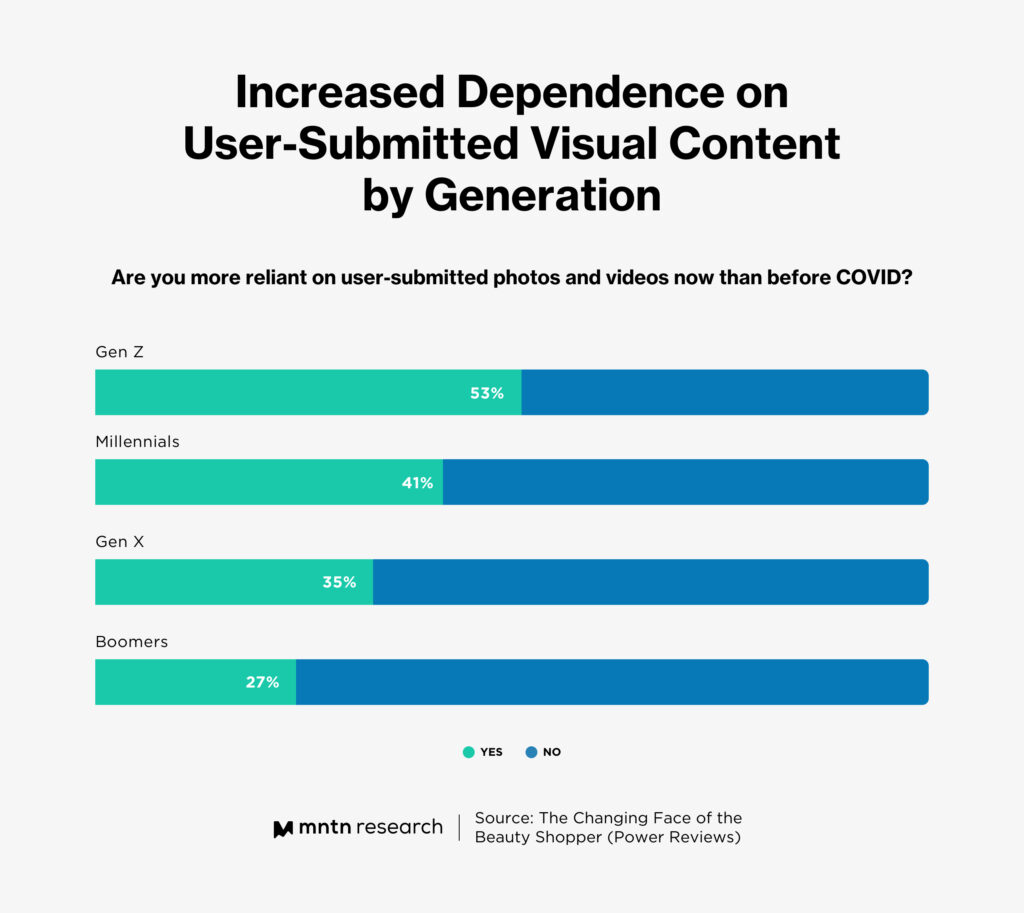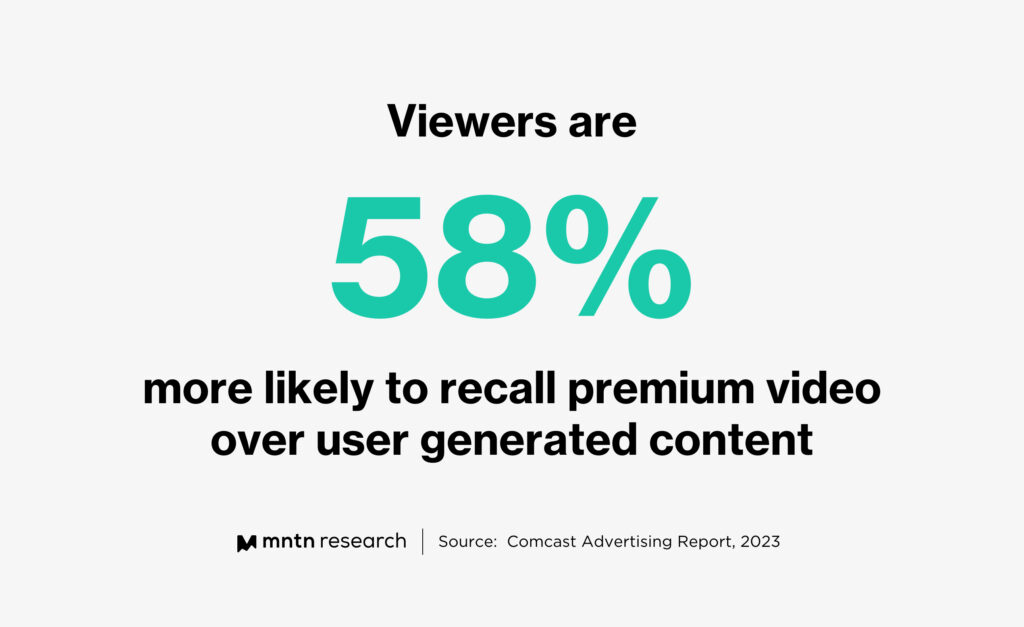Analysis
Why Have Audience Preferences Shifted from User Generated Content to Premium Video?
by Jacob Trussell7 min read
Abstract
- User Generated Content has reigned supreme in the land of video advertising over the last several years.
- However, according to recent reports from Comcast Advertising, the weight this creative style carries has begun to dwindle.
- If you want to make the most out of your streaming TV investment, you should aim to produce premium ads for premium-quality streaming networks.
In past MNTN Research articles, we’ve discussed the benefits of producing User-Generated Content (UGC), or content that mimics the style of UGC, but shot by a video professional.
A report from Stackla a few years back found that UGC had a major impact on the purchasing decisions of 79% of people — that it was 9.8x more impactful than influencer content. In a separate survey from Deloitte published as recently as this spring, 48% of consumers said UGC videos help them discover new products and services. That number increased to 70% when refined to Gen Z consumers alone.

And in a 2021 survey from Power Reviews focused on beauty shoppers, 38% said user-generated content was more important now than it was pre-pandemic. Much like in the Deloitte study, that number increased to 53% when refined to Gen Z shoppers.

In marketing and advertising, UGC can establish social proof through the format’s inherent authenticity. Social proof — a concept popularized in the 1980s — occurs when consumers see or hear about someone earnestly enjoying a product and come to want that product themselves as a result.
There’s nothing quite like seeing someone who reminds you of yourself (or your friends and family) espousing the benefits of a product or service. This sense of relatability and trust makes us more likely to be swayed by the message, because it feels like it comes from someone we might know, or be influenced by, in real life.
This is why we’ve recommended in the past leveraging User Generated Content in Connected TV advertising. It conveys a message in a way that feels less salesy — it’s a softer sell that’s just as compelling because it doesn’t feel like a targeted ad.
But all good formats must come to an end, for a little while, at least. Despite (or perhaps because of) the ubiquity of UGC content — not to mention the utility of being able to repurpose it across an array of platforms — the weight it carries as a creative format seems to be on the outs lately.
A Creative Shift
According to a recent study from Comcast Advertising, viewers are now 58% more likely to recall premium, professionally-produced video over user-generated content.

While the divide between those who prefer premium content over UGC is under 10% — showing that you can’t completely count out UGC in your media mix — it’s still a distinct shift from the last few years wherein the style has reigned supreme. Industry thought leaders are even indicating that a wave of “anti-authenticity” may well be on the horizon, which would hammer another nail into UGC’s coffin.
If you’ve been a loyal reader of MNTN Research, you may be able to predict why this preference shift is occurring. Viewership on CTV over the past several years has been steadily increasing, which means more and more consumers are accustomed to having premium quality content at their fingertips, no matter what device they are on. Is it that surprising, then, that audiences now also want ads to be premium-quality as well?
While you can get premium quality content no matter the size of the screen, TV still commands a large swath of attention. As Comcast Advertising Report states, “82% of streaming viewing happens on a TV screen, where research shows people pay more attention and take action more frequently than with ads seen on a small screen.”

One could argue it’s even simpler than that: the more people are streaming TV, the more accustomed they are to ad-supported streaming TV services, whether that’s a FAST network like Tubi, or a major streaming power player like Netflix — and the higher their expectations for the quality of those ads. A quality that can’t quite be accomplished with User Generated Content.
And as more audiences watch more ads on more big screens, something else has naturally occurred. Viewers just straight up enjoy ads more on TV than they do in digital mobile environments — we’re talking upwards of 15% more.

This is all compounded by the fact that, as Comcast reports, unaided recall with Big Screen TV ads is 2.2x higher, and purchase intent is 1.3x higher, compared to the same ad in a mobile digital in-stream environment. That means with a premium quality TV ad, not only will your audiences enjoy your creative more, they’ll remember it better too.
How Video Production Partners Can Help Brands Scale Premium Creative
That’s not to say Big Screen TV ads are only engaging because of their premium production value. You don’t need a huge budget to produce an effective, entertaining, and memorable CTV commercial. With a little in-house ingenuity — or access to a video production partner — you can produce effective ads that hit the mark without squeezing your marketing department’s wallet.
One thing those video production partners can do is help you maximize your budget through nuanced campaign planning. The quickest way to balloon your production budget is having to go back in-studio or on-location for a pick-up shoot. It can delay campaigns and surface hidden costs you may have been able to avoid with a more detailed production schedule.
That’s why our friends at QuickFrame by MNTN suggest planning to capture all the footage you need in a single shoot. Prepare for this in pre-production by being strategic about who you’re targeting, where you want your ads to run, and what messages you want to convey throughout the lifecycle of your campaign. With these key metrics in mind, you can then design a production plan that captures every single bit of footage you’ll need, from different talent to script variations and even net-new concepts — all in one day.
Take the healthcare services brand that used this strategy, for example. Its team saw a windfall of positive performance, with 33% reduction in CPA over the lifetime of the campaign and an overall CPA that was 31% lower than their original goal, all of which allowed them to increase ad spend 2x while maintaining a positive ROI.
Beat the Competition with Premium CTV Ads
While the data from Comcast is certainly eye-opening, this overall shift in content preference probably isn’t a complete surprise. After all, audiences have become more accustomed to premium-quality ads as they turn to streaming TV in record numbers. Advertisers have kept a keen eye on this migration, and are upping their video ad spend in the process.
Based on Comcast’s report, nearly 40% of advertisers said they increased streaming video spend in 2023, with 27% increasing their spend on Free Ad-Supported Streaming TV services.

And, according to eMarketer, total CTV ad spend will hit $25 billion in 2023, up $5 billion from 2022. As streaming continues to cut into Linear TV’s spend, those numbers are projected to reach $40.9 billion by 2027.
But it’s not just Linear TV losing budgets to CTV. It’s also other digital video channels, like social media, where User Generated Content has reigned for years. That same eMarketer report indicated that 36% of marketers will fund CTV with money reallocated from other digital video channels, and 31% plan to specifically pull from their social media spend.
All this is to say, if you aren’t investing in Connected TV advertising, now is the time. Not only do the numbers above indicate the growing opportunities on the platform, but it also reveals something else. If you aren’t advertising on CTV, chances are high that your competition certainly is.
So if you want to beat ‘em — you better join ‘em.
Subscribe to the MNTN Research Weekly
Sign up to receive a weekly feed of curated research, sent straight to your inbox.